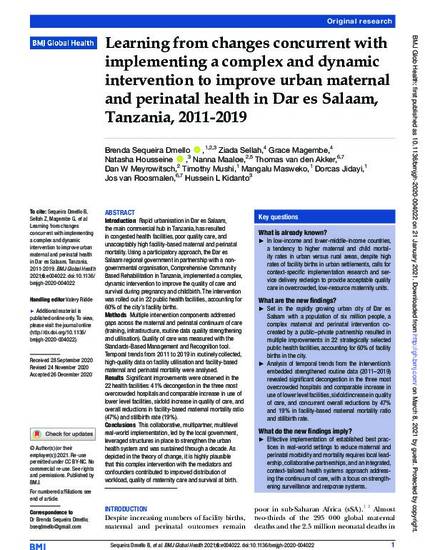
Introduction Rapid urbanisation in Dar es Salaam, the main commercial hub in Tanzania, has resulted in congested health facilities, poor quality care, and unacceptably high facility-based maternal and perinatal mortality. Using a participatory approach, the Dar es Salaam regional government in partnership with a non-governmental organisation, Comprehensive Community Based Rehabilitation in Tanzania, implemented a complex, dynamic intervention to improve the quality of care and survival during pregnancy and childbirth. The intervention was rolled out in 22 public health facilities, accounting for 60% of the city’s facility births.
Methods Multiple intervention components addressed gaps across the maternal and perinatal continuum of care (training, infrastructure, routine data quality strengthening and utilisation). Quality of care was measured with the Standards-Based Management and Recognition tool. Temporal trends from 2011 to 2019 in routinely collected, high-quality data on facility utilisation and facility-based maternal and perinatal mortality were analysed.
Results Significant improvements were observed in the 22 health facilities: 41% decongestion in the three most overcrowded hospitals and comparable increase in use of lower level facilities, sixfold increase in quality of care, and overall reductions in facility-based maternal mortality ratio (47%) and stillbirth rate (19%).
Conclusions This collaborative, multipartner, multilevel real-world implementation, led by the local government, leveraged structures in place to strengthen the urban health system and was sustained through a decade. As depicted in the theory of change, it is highly plausible that this complex intervention with the mediators and confounders contributed to improved distribution of workload, quality of maternity care and survival at birth.
Dmello, B. S., Sellah, Z., Magembe, G., Housseine, N., Maaløe, N., Van Den Akker, T., ... & Kidanto, H. L. (2021). Learning from changes concurrent with implementing a complex and dynamic intervention to improve urban maternal and perinatal health in Dar es Salaam, Tanzania, 2011-2019. BMJ global health, 6(1), e004022.
